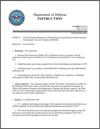Army asks industry for new kinds
of unmanned
systems sensing in GPS-denied
environments
October 21, 2015

PICATINNY ARSENAL, N.J., 21 Oct. 2015. U.S. Army researchers are
navigate in areas where Global Positioning System (GPS) satellite navigation is
unavailable or jammed.
Officials of the Army Armament Research, Development and Engineering Center
(ARDEC) at Picatinny Arsenal, N.J., issued a sources-sought notice Tuesday
(W15QKN16X2843) for the Autonomous Unmanned Systems Teaming and
Collaboration In GPS-Denied Environments (AUSTC) project.
This initiative focuses on identifying and maturing revolutionary and
game-changing autonomous unmanned systems sensing and collaborating
architectures and related components necessary for today's GPS-denied
target-defeat system platforms.

Target-defeat systems can involve weapons specially designed to attack and
destroy high-priority targets like hardened and deeply buried enemy facilities
that are researching and building nuclear, biological, and chemical weapons.
Army researchers want to determine the technical risks of integrating new and
previously developed autonomous unmanned systems sensing technologies to
enable unmanned systems to sense their environment and work together in areas
without use of GPS signals.
Precision GPS-denied mapping, localization, target detection, tracking, and
collaboration capabilities could open a unique pathway that allows for new
methods of sensing existing and emerging threats, Army researchers say.
ARDEC experts want to refine and develop this AUSTC technology with help
from a system prototype. The contractor or contractors chosen for this program
will provide engineering services, hardware, and software development for
existing and new AUSTC technologies.
The job will involve design, development, prototyping, testing, and deployment
of AUSTC technology for situational awareness, collaboration, and engagement
for unmanned system autonomy, 3D and 4D mapping, localization, target
identification, tracking, collective 3D visualization, advanced real-time analysis,
GPS-denied environment radio communications networks,
target engagement, and collaboration.
in U.S. Defense electronicsThis is a subject of critical need but not one
that can be discussed openly in any detail. So this article will highlight
some of the reasons behind the need for integrated security
features in defense electronic systems.
The technologies developed under the AUSTC project should be applicable to small
unmanned aerial vehicles (SUAVs), unmanned underwater vehicles (UUVs), and
unmanned ground vehicles (UGVs) -- particularly those that will be involved in
attacking sensitive targets like nuclear, biological, and chemical weapons labs.
Companies interested should email relevant capabilities and information to ARDEC
no later than 3 Nov. 2015 to the Army's Stephanie Milne at
For questions or concerns contact the Army's Stephanie Milne by email at
stephanie.e.milne.civ@mail.mil, or by phone at 973-724-8782. Also contact
the Army's Christie Vicci by email at
christie.r.vicci.civ@mail.mil, or by phone at 973-724-4179.
More information is online at



Nenhum comentário:
Postar um comentário